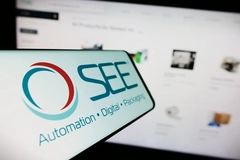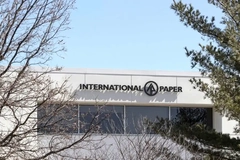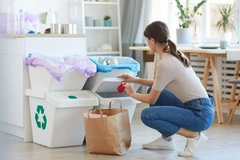Coveris develops different sandwich skillets for Europe and UK’s conflicting shelf life demands
27 Oct 2021 --- Coveris has developed two separate sandwich skillets to meet the different shelf life requirements of mainland Europe and the UK.
The modified atmosphere RecyclaPEel MAP sandwich skillet – launched at FachPack 2021 – is designed to provide extended shelf life for the European food-on-the-move and convenience sectors.
Meanwhile, the RecyclaPaper monomaterial skillet – launched at Lunch! – is an entirely paper-based, recyclable solution featuring a translucent window for product visibility. The solution is designed for shorter shelf life.
Short versus longer shelf life
Will Mercer, business unit R&D director graphics for label and board at Coveris, discusses mainland Europe and the UK’s varying sandwich packaging demands and outlines the benefits and differences between these two solutions.
“Based on the UK’s size, its advanced retail supply chain and the consumption habits of fresh sandwich products, there is less of a local requirement for extended shelf life due to the speed at which these products are consumed on-the-go,” he tells PackagingInsights.
“With European food trends focusing on a wider range of cultural foods and other lunch options, there has been less of a demand for sandwich packaging historically. However, this has recently grown due to the convenience and availability of pre-packaged options.” The RecyclaPaper monomaterial skillet for the UK market.
The RecyclaPaper monomaterial skillet for the UK market.
“Given this change in demand, supply chains are now having to catch up, and the quality and length of the distribution chains across Europe are more challenging with the risk of high levels of food waste, resulting in the need for extended shelf life solutions.”
Mercer adds that the variety of European sandwich options is significantly less complex than the UK’s and better suited to gas-flush, extended shelf life technology. UK variants often consist of complex ingredient mixes, meaning significant shelf life extension cannot be achieved.
Paper’s barrier limitations
RecyclaPEel MAP is an evolution of Coveris’ peelable and separable RecyclaPEel sandwich skillet, made from fully recyclable cartonboard and PE liner components. The skillet’s design enables the lined corners to form a tight gas seal.
When packed using a gas-flush process, the tight seal retains control of the pack’s atmosphere over the product’s life cycle, extending shelf life significantly beyond the four days achieved with Coveris’ lined board skillets typically used in the UK market, subject to testing and ingredients used.
“The functionality of the RecyclaPaper liner material in the pack make-up is designed for short shelf life consumption. The liner demands required for a MAP solution to deliver the hermetic seal cannot currently be achieved using paper,” explains Mercer.
“Going forward, we are looking at fundamental design changes, which may allow for an ‘all paper’ MAP skillet. However, as both solutions deliver recyclability benefits, this will be driven by consumer demand.” Will Mercer, business unit R&D director graphics for label and board at Coveris, at FachPack 2021.
Will Mercer, business unit R&D director graphics for label and board at Coveris, at FachPack 2021.
Coveris also launched a “potentially revolutionary” paper for dry foods to meet the growing demand for recyclable alternatives to plastic-based solutions at FachPack 2021. Notably, PaperBarrier Seal’s barrier properties are competitive with plastic, mitigating food waste.
Mercer reiterates that for the company’s sandwich skillet offering, its paper does not match the necessary functionality of the plastic liner. “However, once we have concluded work on a fundamentally different pack design, it may be possible to introduce the PaperBarrier technology into this arena,” he adds.
Maximizing recyclability
RecyclaPEel MAP sandwich skillets are designed with a peelable PE membrane, enabling consumers to separate the cartonboard and PE liner components easily for recycling. The skillets can be recycled within paper recycling infrastructures with reduced adhesion, allowing the PE liner to detach during the process for maximum board recovery.
“If fully separated and placed into a plastic store or kerbside collection, the PE component is fully recyclable as is any PE film in a dedicated recycling stream,” notes Mercer. “The principal reason for the development of the separable liner is to maximize the recovery of the majority fiber component when recycling packs at a paper recycling facility.”
“Traditionally, films would have been fully anchored to the board, either by the extrusion coating or lamination process, which resulted in the potential loss of both the film and a high level of fiber, due to the level of adhesion and short recycling processing time.”
However, he explains by developing a detachable liner, the film can quickly release, removing minimum fiber while maximizing the overall fiber recovery rate. Coveris’ “potentially revolutionary” PaperBarrier Seal.
Coveris’ “potentially revolutionary” PaperBarrier Seal.
The recyclability of plastics is making headlines after UK Prime minister Boris Johnson claimed plastics recycling “doesn’t work” and “doesn’t begin to address the [pollution] problem.” Johnson’s comments were met with fierce criticism by the recycling industry ahead of the COP26 climate change summit.
Product visibility and integrity
RecyclaPEel MAP skillets are printable in up to nine colors, delivering on-shelf appeal and product visibility, with an anti-mist option also available.
“The biggest challenges in introducing a MAP pack into the sandwich skillet range is the need to guarantee the pack’s integrity once flushed and sealed and the complexity of the ingredients,” says Mercer.
“However, within Europe, the complexity of the build is significantly less challenging.”
Speaking at FachPack 2021, Mercer discussed the company’s other circular economy solutions, namely its MonoFlex monomaterials range, Duralite R Recycled shrink film, wash-off labels and linerless label punnets.
By Joshua Poole












